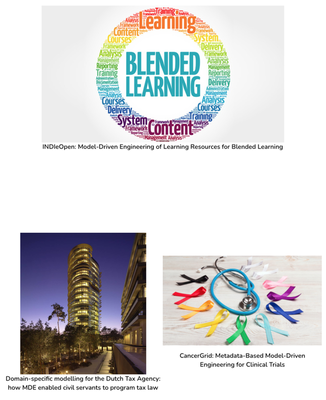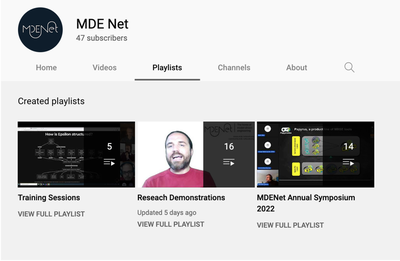Bringing Together Research and Practice
How a KCL academic has built MDENet, a new community for engineers so that they can write better and more efficient software
Software engineers are in high demand. With numbers of new jobs exploding, there is a real risk of an impossibly complex patchwork of different and competing engineering approaches. Dr Steffen Zschaler and his team have built a new community network that helps academics and practitioners to get together, share best practices and ground their coding methodologies on sound, model-based approaches.
‘Software is eating the world’, a commentator in The Wall Street Journal remarked in 2011. Fast forward a decade, and software applications have only become even more ubiquitous. The demand for software developers has never been higher; in the UK alone their number has almost doubled to 500,000 over the past ten years. Over the years to come, nearly 200,000 new vacancies annually for software developers are to be expected worldwide, leading to what experts call a significant scarcity of fresh talent. This jump in the number of people writing code and building applications raises the important question, how do they actually go about doing it? It can’t be assumed that approaches align, which makes more clutter, noise and diversion in software engineering more likely.
If there are too many cooks in the proverbial kitchen, the real danger is that they’ll spoil the soup. Dr Zschaler, Director of MDENet and Reader in Software Engineering at KCL Informatics, and his team have set themselves the task to bring some order into the disarray of approaches. Their solution: let’s build a network that brings engineers and academics together around a sound methodology such as MDE, short for Model-Driven Engineering, which allows managing complexity and enables subject-matter experts to contribute to the development of software. This is how MDENet was born: a network for software engineers to develop and share model-based approaches.
Background
Attempts at a unified approach to software engineering have a long history, Dr Zschaler explains. Model-based approaches had enjoyed waves of popularity before but, not unlike the history of Artificial Intelligence, would ebb away again. ‘What we’ve seen in this MDE world is that there’s been a lot of these moments of big hype and big promise, for a long time, quite like the Gartner Hype Cycle’, he continues. But it wasn’t until several iterations of hype and disinterest had been worked through that MDE really started to take off.
‘Today, we see a lot more interest from industry to the point where even the Software Engineering Institute in the US, a very influential body in the software engineering field, wrote a new report recently about the future of software engineering in which a key issue is the importance of MDE’, Dr Zschaler takes stock. ‘They recognise that MDE allows you to get on top of things and to better manage the complexity of modern software systems by allowing you to separate out your concerns into individual modelling languages, and through code generation and transformation, combine those into the final software’. Thanks to this proliferation of serious interest in model-based approaches, the time had come to launch a network that gets experts and practitioners together.

What exactly did the team do?
In 2018, things started to move fast. ‘I kind of went, wow, there’s suddenly a lot of industry people who are really interested in all of this; really interested in the practical applications of MDE’, Dr Zschaler recalls. ‘They were really exploring how they can make MDE useful for themselves, which was something I hadn’t seen quite as much before’. The network then emerged from the idea to get everyone together. The ACM/IEEE 21st MODELS conference would prove exactly the right outlet for MDENet’s founding members to get together and brainstorm about building a new community platform. ‘That was when we started talking about this network and we said, look, this is the time we need to make sure that the community comes together so that we can develop training materials, so that we can talk about this technology, so that we can make it easier for people to get into MDE because it’s getting to the point where it’s becoming really usable’, Dr Zschaler sums up the inception of MDENet.
The impact so far
The network has already attracted 271 prolific members and the number keeps growing. ‘On average we’ve got one or two new people a day from all over the world who join and they go across all levels: academic staff, PhD students, and from industry’, Dr Zschaler continues.
Recently, the team had put together the annual MDENet symposium. A dozen or so talks and workshops were scheduled over a busy two days. Presenters were also given the chance to give shorter talks too – this proved a great way to discuss nascent work, or projects in progress that are still in the early stages. ‘I believe this is very much what the network is about: it’s about building these links and connections, building on these discussions’, Dr Zschaler explains.
The team also runs monthly demonstration workshops that focus on practical applications. Recordings of the talks and demonstrations can be found on MDENet’s YouTube channel. The team also put together a wide range of online resources available to members that help guide novices and experts in their research projects. To this end, KCL Informatics has proved to be an excellent home for MDENet. ‘The Informatics Department at KCL is an internationally recognised institution and that always helps, of course, with networking activities – we’re already based at a very strong hub!’, Dr Zschaler points out.
MDENet members have already assembled a variety of projects that draw on the principles of model-based software engineering and development. They range from optimising learning resources for blended learning, to helping civil servants in the Netherlands to program tax laws more efficiently, to using metadata from cancer research for clinical trials.
Looking ahead: the next steps
There is no stopping MDENet at this point – Dr Zschaler and his team are already busy planning the next symposium. ‘We really want to develop the symposium into our big annual flagship event, idbeeally in December’, he outlines the future development of MDENet. There are also plans to grow teaching resources for MDENet members so that they are able to share their MDE teaching experience with colleagues.
It’s the community that will shape MDENet over the years to come. ‘I believe the success of the network depends and builds on the willingness of our members to contribute and to use the network as a channel for communicating their ideas. And their work, their progress, their successes’, Dr Zschaler sums up. The way things are going for MDENet, it seems exactly the kind of platform the community had been waiting for.
This story was written by Juljan Krause, a professional science writer and final-year PhD Researcher in quantum communication.
